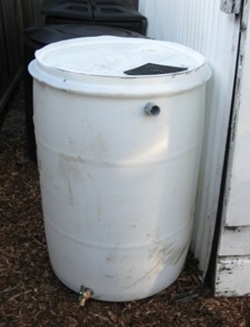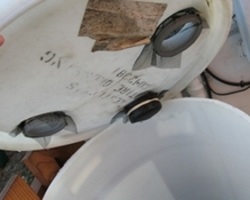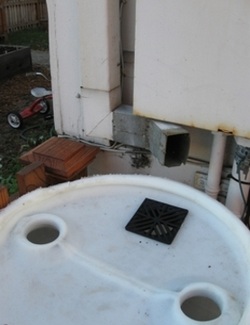
The idea of rain barrels is to harvest and store the rainwater that is routed down a building's downspouts and use it at a later time. Since we are also expanding our food-producing garden extensively, it will be even more helpful to have extra water on hand to keep it irrigated.
The first step was to find a source of 55-gallon food-grade (HDPE) plastic barrels. That type of barrels is used to distribute all kinds of items, including food ingredients (particularly liquids or foods packed in liquids). Sometimes the barrels will be sent back and re-used after they are emptied, but they are often just thrown away. For our purposes, it was also important to get barrels that had not contained toxic substances. They also have to be strong enough to be filled with water, so trash cans generally won't work.

The next step was to convert them to rain barrels. I worked with our neighbor Michael to determine the best approach, and we came up with something pretty simple. There are a number of great DIY write-ups online (some listed below), so I'm not going to go into too much detail on ours.
Basically, we:
- Cut off the top of the barrel to give us access to the inside. The barrels we got have a nice wide lip wider than the rest of the barrel, so flipping the lid over then gives it a nice fit.
- Cut a hole near the bottom of the barrel and fasten a hose bib (spigot).
- Cut a hole near the top for overflow.
- Cut a hole in the lid for the water to enter. I went to the trouble of buying some plastic drain pieces to make it a little prettier, but that's not necessary.
- Cover all openings with fiberglass mesh to keep mosquitos out.
We've converted two barrels so far, and the total cost for parts came out to about $20 per barrel.

- Single barrel
- Linked barrels (fairly simple)
- Linked barrels (rather complex)
- Linked barrels, mounted horizontally in a frame
- Rain Barrel Guide: Good general overview
- HarvestH20: The Rainwater Harvesting Community
- Guidelines for storing water
- American Rainwater Catchment Systems Association
 RSS Feed
RSS Feed